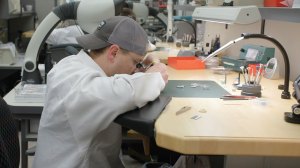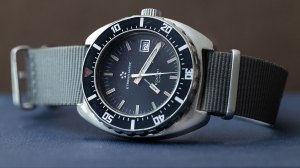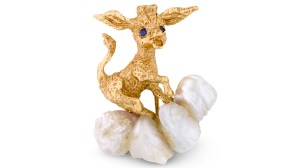In 2016, Fred Savage, the actor best known for starring in the 1980s and ’90s comedy series The Wonder Years, was ready to take his watch hobby to the next level. The Chicago-born collector had caught the watch bug in the late 1990s when he began buying vintage pieces—mostly American-made brands such as Illinois—from a trusted dealer in Los Angeles. As he gained confidence in his knowledge, he decided to expand his collection to include more noteworthy pieces.
“I knew enough to be dangerous,” Savage tells Robb Report at a café in Encino, Calif., in mid-January. “But I did not know what I didn’t know. I bought a watch online from a big auction house. It was a Rolex 1803 Day-Date on a white gold President. It felt good, looked good. I loved it.”
Savage spent what he calls “a significant” but not life-changing amount on the watch and proudly showed it off to fellow collectors—until one of them burst his bubble. “He was like, ‘Oh, that watch has been redialed.’ He could just tell from the photo. And I’m like, ‘What are you talking about?’ I didn’t even know what ‘redialed’ meant. He goes, ‘Well, look.’ And then once it’s pointed out to you, you can’t unsee it. You look at it through a loupe and you see that the printing is off, and the serif on the ‘x’ isn’t straight, and the hash marks aren’t evenly spaced.
“I was crestfallen,” Savage says.
The experience was disheartening, but it sparked an idea. “After that, I kept thinking, ‘How are you supposed to know?’ When you look at all these other collectible verticals—whether it’s sports cards, comic books, coins, shoes or even video games—they all have one, if not multiple, third-party authentication and grading services.”
Fred Savage’s Eterna-Matic Super Kontiki
Fred Savage
Savage—who wore a special edition of the Eterna-Matic Super Kontiki, a vintage dive watch, issued to members of the Israel Defense Forces in the 1970s—referred to the Gemological Institute of America, or GIA, the lab that dominates the market for diamond grading reports. “You’d be a fool to buy a diamond of significance if it’s not GIA graded.
“I realized watches was missing that,” he says.
Despite the size and growth of the pre-owned watch market—which, today, is estimated at $24 billion—the industry lacks a notable third-party grading and authentication service for reasons both obvious and nuanced (“With sports cards or coins, you’re grading one element,” Savage offers. “There are hundreds of components to a watch. It’s really daunting.”) During the back-to-back writers’ and SAG strikes of 2022, Savage became serious about creating one.
Timepiece Grading Specialists, or TGS, the company he founded in 2022, officially went live in late January. Based in Dayton, Ohio, where Savage works from the offices of Stoll & Co., a watch service business established by Ron Stoll in 1982, TGS provides reports on a watch’s condition, starting at $250 (not to exceed 3% of a watch’s value).

A watchmaker at Stoll & Co. grades a timepiece for TGS
TGS
Savage decided to partner with Stoll, who runs the company with his daughter, Emily, after crisscrossing the country over the course of eight months in search of qualified service centers. “I knew that to do this properly, you needed to have the watches in hand, and you needed to have someone who could handle them and open them up and look inside,” Savage says. “And I don’t have that technical skill.”
“What the Stolls have built from humble beginnings is a state-of-the-art facility,” he says. “They have 40 watchmakers, experts in every luxury brand. Because they have such an incredible breadth and depth of knowledge, they partnered with eBay and run the eBay authentication program.”
TGS also offers watch appraisal, repair and storage, for additional costs, but its core service is grading and authentication, which Savage describes as two sides of the same coin. “If you grade something and don’t authenticate it, the grade’s not worth it,” he says. “And then if you authenticate it and don’t grade it, the authentication is the hardest part because you’re looking at every component of it. They’re intrinsically linked.”

A watch specialist at Stoll & Co. inspects a watch for TGS grading
TGS
Once a watch arrives at the Dayton facility, Savage and the team of specialists at Stoll photograph it, assess every component and assign each its own score. “There’s a score for the crown, the lugs, the case, the dial, the movement, the componentry, the bracelet, the hardware, the case back,” Savage says. “And we do a timing slip to show how it’s running.
“And then we have a weighted formula,” he adds. “A scratch on the crystal shouldn’t equal a scratch on the dial. One is much more important to the condition of the watch. It all gets spit out and we get one overall score for the watch. So when you’re buying online or when you’re buying from a dealer or someone you might know or might not know, there are no surprises. You’re seeing a watch, warts and all.”
Beyond bringing peace of mind to individual buyers—particularly those who don’t have access to the finest dealers, whom Savage acknowledges offer trustworthy authentication services of their own, if unofficially—the watch entrepreneur thinks TGS is helping to grow the secondary market by making it more transparent.

Watch specialists at Stoll & Co. grade timepieces for TGS
TGS
“I’m not taking anything away from the top dealers,” Savage says. “But I think that to do it well and correctly, you have to be third-party. You can’t have a stake in the value of the watch or what it trades for. Our goal is to look totally objectively at a timepiece and evaluate it as an object with no vested interest in the outcome other than a customer having more knowledge than they came in with.
“The business has grown so much that I think there needs to be some sort of playing field leveler so that everyone’s dealing on the up and up, and everyone’s speaking the same language.”
On that note, the lexicon of watch condition has proven to be one of TGS’s thorniest issues.
“We want to make sure that a scratch is a scratch is a scratch,” Savage says. “Corrosion is corrosion. ‘Heavy corrosion’ is different than ‘light corrosion.’ A ding, a chip, all these things are meaningful. The language is out there. We just want to standardize what we mean so there’s no confusion. We’ve had lots of conversations about few, some, many, more. ‘A few light scratches,’ like three light scratches—how is that different from ‘many light scratches,’ or ‘multiple light scratches’? For this to be valuable, you have to spend hours thinking about and debating the differences between some, many, few, more. You have to be consistent and you have to put a lot of thought into it.”
Savage has certainly done that. He is now partly based in Dayton, where he rents an apartment and bought a car, a used Subaru. He’s even got status on Spirit Airlines, the only carrier that flies direct from L.A. to nearby Columbus (“I’m a gold member, not tooting my horn or anything,” he says, laughing).
“We have two guiding philosophies,” Savage says. “The first is we want to democratize knowledge. If you wanted to spend a year researching something, you could try and do it. But I want everyone to feel like they have an expert in their pocket.
“Our other big thing is we want to empower the collector. I feel like every person buying a watch on the secondary market deserves the same confidence and same peace of mind that anyone who buys a vintage comic book or a vintage coin or an old Super Mario Bros. game has. When I sat down to buy my wife’s engagement ring, I didn’t know anything about buying jewels. But I had my GIA cert in my hand, and I could sit across from someone who had dealt diamonds for 40 years and have a knowledgeable conversation about inclusions. And I felt empowered by that. I want to empower collectors and buyers watching the secondary market with that same knowledge.”
Authors
-

Victoria Gomelsky
Victoria Gomelsky is editor-in-chief of the jewelry trade publication JCK and a frequent contributor to the New York Times and Robb Report. Her freelance work has appeared in AFAR, WSJ Magazine, The…
Credit: robbreport.com










